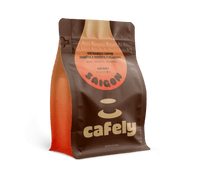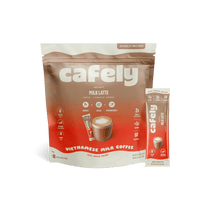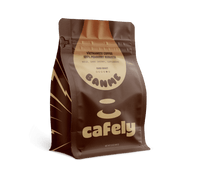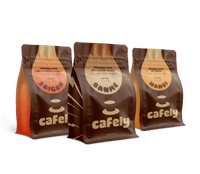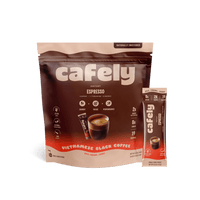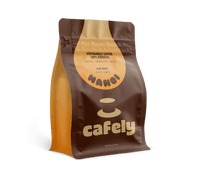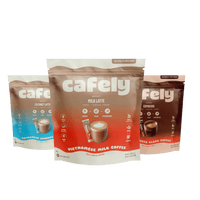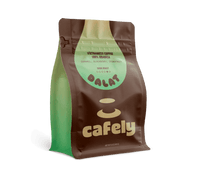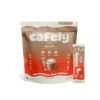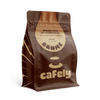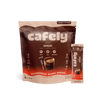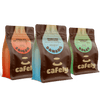The latte is one of the most versatile drinks in the coffee world. From bold espresso blends to colorful tea-based options, there’s a latte for every taste and mood — and it’s a major contributor to global coffee consumption statistics.
This guide breaks down the most popular types of lattes, so you can find your go-to or try something completely new.
What Are Lattes? A Quick Guide to the Basics
At its core, a latte is a combination of espresso and steamed milk — smooth, balanced, and endlessly adaptable. The word latte simply means “milk” in Italian, but in coffee shops, it’s short for caffè latte, which translates to “coffee with milk.”
The standard latte starts with one or two shots of espresso, followed by steamed milk, usually in a 1:3 or 1:4 espresso-to-milk ratio. This makes lattes creamier than a standard cup of cappuccino and more mellow than a straight shot or a macchiato.
While the traditional version is served hot in a 10–12 oz cup, lattes can also be made iced similar to regular iced coffee or blended. The base stays the same, but everything else is customizable.
No matter if you’re ordering from your favorite café or making one at home, a latte is a canvas, and the options go far beyond just espresso.
Popular Types of Lattes
Lattes come in far more styles than the classic hot version you see in most cafés.
Here’s a breakdown of the most common types of lattes, organized by category:
1. Classic Espresso-Based Lattes

These stick to the original latte structure — espresso and steamed milk. The flavor depends on the coffee-to-milk ratio and whether it’s served hot or cold.
- Caffé Latte: The standard. One shot of espresso with a generous pour of steamed milk, usually topped with a small layer of foam. Mild, creamy, and balanced.
- Iced Latte: Espresso poured over cold milk and ice. Smooth and refreshing with the same flavor as a hot latte, just cooler and lighter in texture.
- Doppio Latte: Made with a double shot of espresso for a bolder, more robust flavor. Great for those who want maximum amount of caffeine without adding sweetness.
- Spanish Latte: Combines espresso with steamed milk and sweetened condensed milk. The result is a creamy, sweet drink with rich flavor that can be served hot or iced.
- Café con Leche: Common in Latin American countries. Typically equal parts strong coffee or espresso and steamed milk. It resembles a latte in structure and flavor.
2. Flavored Lattes
These start with a standard espresso-milk base and get a flavor boost from syrups or sauces.
- Vanilla Latte: Lightly sweet with a smooth, mellow vanilla taste. Pairs well with most milk types.
- Caramel Latte: Rich and buttery. Made with caramel syrup and often topped with caramel drizzle.
- Mocha Latte: A blend of espresso, chocolate syrup or powder, and steamed milk. Sweeter and more indulgent, often topped with whipped cream.
- Hazelnut Latte: Nutty and warm, with a smooth finish. A popular pairing with oat or almond milk.
- Pumpkin Spice Latte: Seasonal fall favorite with cinnamon, nutmeg, clove, and pumpkin syrup. Usually topped with whipped cream and spices.
- Honey Lavender Latte: Combines floral lavender notes with the subtle sweetness of honey. A light, calming twist on the classic latte.
These lattes can be made hot, iced, or even blended, depending on preference. If you're looking for lighter options, you might want to explore how to sweeten your coffee without sugar for a healthier twist on your favorites.
3. Tea-Based Lattes (Espresso-Free)
These skip espresso altogether and use tea or tea powders as the base. They still follow the latte format, brewed base plus milk, but cater to non-coffee drinkers.
- Matcha Latte: Made with finely ground green tea powder (matcha) whisked into hot milk. Earthy, slightly bitter, and packed with antioxidants.
- Chai Latte: Spiced black tea concentrate (usually with cinnamon, cardamom, ginger, cloves) mixed with milk. Sweet, spicy, and warming.
- London Fog: Steeped Earl Grey tea with vanilla syrup and steamed milk. Light, citrusy, and creamy.
- Hojicha Latte: Made with roasted green tea instead of matcha. It has a lower caffeine content and a nutty, toasty flavor.
These options are ideal for those avoiding espresso or looking for something different in the morning.
4. Wellness & Herbal Lattes
Often called “functional lattes,” these coffee alternatives focus on natural ingredients with health-related benefits. They’re usually caffeine-free and known for their vibrant colors and flavors.
- Turmeric Latte (Golden Milk): A blend of turmeric, ginger, black pepper, and steamed milk. Anti-inflammatory and earthy with a warming feel.
- Beetroot / Red Velvet Latte: Made with beet powder, sometimes mixed with cocoa. Naturally sweet, rich in antioxidants, and bright pink in color.
- Blue Spirulina Latte: Uses blue-green algae powder (spirulina) for its vibrant hue and nutritional benefits. Mild taste with a subtle ocean-like finish.
- Mushroom Latte: Includes functional mushrooms like reishi, chaga, or lion’s mane. Earthy flavor and promoted for calm or focus.
- Rose / Lavender Latte: Floral infusions are often combined with milk and mild sweeteners like honey or agave. Calming, lightly aromatic, and caffeine-free.
These lattes are typically served hot but can also be iced depending on the ingredients.
5. Milk-Alternative Lattes

These use plant-based milk instead of dairy, often for taste, dietary, or ethical reasons.
- Almond Milk Latte: Slightly nutty and light. It can be thinner depending on the brand.
- Oat Milk Latte: Naturally creamy and smooth. Popular in cafés for its ability to steam well and complement espresso.
- Coconut Milk Latte: Sweet and tropical with a strong coconut flavor. Best with iced or flavored lattes.
- Soy Milk Latte: Froths well and offers a neutral flavor. Widely used in coffee shops.
- Cashew or Macadamia Milk Latte: Creamy, slightly sweet, and rich. Less common but gaining popularity for texture.
Any of the previously mentioned lattes can be made with these alternatives. Keep in mind that each milk type froths differently and can impact the texture and flavor of the final drink.
6. Temperature-Based Lattes
Sometimes the only thing that changes is the temperature and texture, but that alone can completely transform your latte experience.
- Hot Latte: The classic. Steamed milk poured over espresso with a layer of microfoam on top. Best for showcasing latte art and sipping slowly.
- Iced Latte: Cold milk combined with espresso and served over ice. More refreshing, with a lighter feel and slightly different flavor perception.
- Blended Latte / Frappe-Style: Espresso, milk, and ice blended together into a creamy, cold drink. Often sweetened and topped with whipped cream or syrup.
Each has different characteristics in the latte’s flavor and body. Some people prefer the clarity of hot lattes, while others enjoy the smooth texture of blended versions.
How to Make the Perfect Latte at Home
With a few tools and these four steps, you can easily make barista-level lattes in your kitchen, either hot or iced.
Here’s how to get started:
What You’ll Need
You’ll need espresso, either from an espresso machine, a Moka pot, or a pod-based system like Nespresso.
A portable milk frother or steam wand is essential for achieving the signature velvety foam, but you can also use a small saucepan to heat milk and a French press to froth manually.
For milk, go with whole milk for richness, or try oat or almond if you prefer plant-based. Both froth well with the right technique.
Step 1: Brew Your Espresso
Use freshly ground, dark-roasted beans and pull 1 to 2 shots of espresso. If you do not have an espresso machine, brew 2 to 3 ounces of concentrated coffee using a Moka pot or pod system. It won’t be a true espresso, but it’ll work in a pinch.
Step 2: Heat and Froth Your Milk
Pour about 6 to 8 ounces of milk into a frothing pitcher or saucepan. Heat gently to around 60 to 65°C (140 to 150°F), just hot enough to steam, but never boiling. Overheating changes the flavor.
Froth the milk until it looks smooth and silky, with a thin layer of foam on top. A steam wand makes this easy, but if you’re using a handheld French press, pump the plunger quickly until you get the right texture.
Whole milk creates the most stable foam. For non-dairy, oat and almond froth are best, just go slow to avoid big bubbles.
Step 3: Combine
Pour the espresso into your cup first. If you want to sweeten it or add flavored syrup, now’s the time.
Next, slowly pour in the steamed milk, using a spoon to hold back the foam. Then spoon the foam over the top for a layered finish.
Step 4: Finish with a Touch of Art (Optional)
If you’re feeling creative, swirl the milk as you pour to shape a simple heart or tulip. Start with microfoam and keep the pour steady; it takes practice, but even a small flourish adds a nice touch.
How to Make an Iced Latte

Perfect for warmer weather, it’s lighter, colder, but still strong in coffee flavor.
What You Need
You’ll need espresso (or a strong brewed alternative), cold milk, and ice. For equipment, grab an espresso machine, Moka pot, or Nespresso machine — whatever you use for hot lattes works here too.
Have a milk frother or handheld whisk if you want to top it with cold foam. A tall glass, stirring spoon, and ice cubes round out the setup.
Use whole milk for a creamier finish, or oat milk for a smooth plant-based version. Make sure the milk is cold straight from the fridge.
Step 1: Brew Your Espresso
Start by brewing 1 to 2 shots of espresso using your preferred method. Let the espresso cool for a minute or two; this helps prevent it from instantly melting the ice and watering down your drink.
Step 2: Fill Your Glass with Ice
Fill a tall glass about ¾ full with ice. The more ice you add, the colder and more balanced the drink will be.
Step 3: Add the Espresso and Milk
Pour the cooled espresso directly over the ice. Then add 6 to 8 ounces of cold milk. Stir gently with a spoon until everything is well mixed.
If you want an extra-luxurious touch, top it with a delicious cold foam. You can just froth cold milk until it’s thick and creamy, then spoon it on top. Sweetened whipped cream also works for a dessert-style version.
Pro Tips for Better Lattes at Home
Level up your latte game with these easy tips that make a noticeable difference in flavor, texture, and presentation.
1. Use Fresh, Dark-Roasted Beans
Fresh beans are the backbone of any great latte. For best results, choose a dark roast arabica or well-balanced blend. Dark roast coffee brings the bold flavor needed to balance out the creaminess of the milk. Check roast dates on the bag and try to use beans within 2–3 weeks of opening.
2. Grind Your Beans Just Before Brewing
Grinding your beans right before brewing helps preserve their oils and aroma. Use a burr grinder for an even, fine grind that’s ideal for espresso machines or moka pots. A consistent grind ensures smoother extraction and better flavor.
3. Froth or Steam Milk Separately
Always prepare your milk on its own, either by steaming it or using a frother. This gives you more control over the final texture and helps you avoid overheating or scalding. Well-frothed milk should be creamy, not bubbly.
4. Add Flavoured Syrups Before the Milk
IIf you like your lattes sweetened, add syrups like vanilla, hazelnut, or caramel to the espresso before pouring in the milk. This helps the flavor blend evenly and keeps it from sinking to the bottom of the cup. If you’re health-conscious, try making your own vanilla syrup at home. You can control the sweetness, skip the preservatives, and use natural ingredients for a cleaner flavor..
5. Choose the Right Milk Alternative
Not all plant milks froth the same. Oat milk is often the best choice for lattes because it foams consistently, holds structure, and has a naturally creamy texture. Almond and soy milk work too, but you may need to froth gently to avoid large bubbles.
6. Practice Your Latte Art
Latte art takes time to master, so don’t be discouraged if your first pours look more abstract than artistic. Start with slow, circular motions to create a smooth swirl. Once you’ve got the milk texture right, you can experiment with hearts and rosettas.
FAQs: Types of Lattes
These quick answers cover the most common questions people have when exploring all the different types of lattes.
1. How Many Types of Lattes are There?
Virtually limitless, from classic espresso-based to tea, herbal, flavored, and dairy-free options.
2. What Kind of Coffee is Best for Lattes?

Espresso is ideal, but strong brewed coffee from a Moka pot or Aeropress also works.
3. Are Lattes Healthy?
Yes, especially when made with unsweetened milk and without sugary syrups or toppings.
4. Which is Stronger, a Cappuccino or a Latte?
Cappuccino. It uses less milk, so the espresso flavor comes through more boldly. However, the strength of each brew varies depending on the type of beans and whether a single or double shot is used.
5. What Milk is Used for Lattes?
Whole milk is traditional, but oat, almond, soy, and other plant-based milks are common alternatives.
6. Should a Latte Be Hot or Cold?
Traditionally, the latte is served hot. However, both options are common. Lattes can be served hot or iced.
7. Is a Frappe Just a Blended Latte?
Not quite. Frappes often use instant coffee, sweeteners, and creamers, while lattes use espresso and steamed or cold milk.
8. How Do You Flavor Lattes?
Add syrups, flavored powders, or natural ingredients like vanilla extract, spices, or even herbs.
9. What Is the Weakest Espresso Drink?
Lattes tend to be milder due to their high milk-to-espresso ratio, making them one of the least intense options.
10. What Is the Easiest Latte Art?
A simple heart or tulip made with microfoam is a great place to start for beginners.
